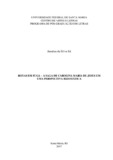| dc.creator | Sá, Janaína da Silva | |
| dc.date.accessioned | 2018-06-27T20:55:44Z | |
| dc.date.available | 2018-06-27T20:55:44Z | |
| dc.date.issued | 2017-08-18 | |
| dc.identifier.uri | http://repositorio.ufsm.br/handle/1/13580 | |
| dc.description.abstract | This work presents, as a starting point, my concerns about the Blacks which I have developed throughout my career as a teacher. With this problematic situation in view, I use Carolina Maria de Jesus‘s discourse, an author from Minas Gerais, to allow me to make new considerations as regards the place, or to the in-between space designed for the Blacks in the end of the twentieth century and its reverberations in the years to come. I believe that the narrative by this author expands itself in a way as to signal that Gilberto Freyre‘s announced racial democracy neglected the Blacks as participants of the national history, rather than included them within a social, republican perspective of a capitalist nature as it was meant for that period. From such an obstacle, I observe that in some of Carolina de Jesus‘ productions the real contradictions of the historical process - from a monarchical system to a republican one - are brought to light; so much so, that it is possible to perceive the procedures of exclusion and exploitation this ethnicity has been submitted since that time. By rescuing this complex figure of identity and difference, I conclude that the ‗carolineano‘ discourse manifests itself through Foucalt‘s fold and it imposes itself as a ‗glowing existence‘, where a saga emerges and is accomplished through an unsteady search for agency. Reading her narratives lead us to take into account Gilles Deleuze and Félix Guattari and consider their thoughts as viable resources to attain a different signification to understand Maria Carolina de Jesus‘discourse. From a rhizomatic perspective it is possible to state her narratives point to the rupture of the norms of a culture built upon homogeneous patterns. | eng |
| dc.language | por | por |
| dc.publisher | Universidade Federal de Santa Maria | por |
| dc.rights | Attribution-NonCommercial-NoDerivatives 4.0 International | * |
| dc.rights.uri | http://creativecommons.org/licenses/by-nc-nd/4.0/ | * |
| dc.subject | Carolina Maria de Jesus | por |
| dc.subject | Existência-clarão | por |
| dc.subject | Lugar | por |
| dc.subject | Rizoma | por |
| dc.subject | Glowing existence | eng |
| dc.subject | Place | eng |
| dc.subject | Rhizome | eng |
| dc.title | Rotas em fuga – a saga de Carolina Maria de Jesus em uma perspectiva rizomática | por |
| dc.title.alternative | Fleeing routes – the saga of Carolina Maria de Jesus in a rhizomatic perspective | eng |
| dc.type | Tese | por |
| dc.description.resumo | Esse trabalho parte de inquietações reproduzidas em minha prática docente acerca da representação do negro. Diante dessa problemática utilizo o discurso da autora mineira Carolina Maria de Jesus que converge para uma retomada de novas apreensões no que se refere ao lugar, ou entre-lugar dimensionado para o negro na sociedade do final do século passado e suas reverberações nos anos seguintes. Suponho que a narrativa dessa escritora se expande como um sinalizador de que a democracia racial, promulgada por Gilberto Freyre, mais negligencia a figura do negro como partícipe da história nacional do que o inclui dentro de uma perspectiva social, republicana e de viés capitalista que se pretendia para a época. A partir desse entrave constato que em algumas produções da autora Carolina Maria de Jesus se verifica as contradições reais do processo histórico de passagem do sistema monárquico para o republicano, a ponto de se perceberem, desde esse tempo, os procedimentos de exclusão e exploração a que essa etnia fora sujeita. Com o resgate dessa figura complexa de identidade e diferença, julgo que o discurso carolineano se manifesta através da dobra foucaultiana e se impõe como uma existência clarão, de onde se pode visualizar todo um movimento de saga que realiza na busca inconstante por agenciamento. A leitura de seu discurso passa pelas considerações de Gilles Deleuze e Féliz Guattari a fim de admiti-la como uma leitura possível dentro de uma perspectiva rizomática. Nessa instância pressinto que esse discurso ganha uma ressignificação e aponta para a subversão dos moldes de uma cultura construída sobre padrões homogeneizantes. | por |
| dc.contributor.advisor1 | Silva, Vera Lucia Lenz Vianna da | |
| dc.contributor.advisor1Lattes | http://lattes.cnpq.br/8773425081130876 | por |
| dc.contributor.referee1 | Rocha, Aristeu Castilhos da | |
| dc.contributor.referee1Lattes | http://lattes.cnpq.br/3178211577215938 | por |
| dc.contributor.referee2 | Gai, Eunice Terezinha Piazza | |
| dc.contributor.referee2Lattes | http://lattes.cnpq.br/7610935214823865 | por |
| dc.contributor.referee3 | Fernandez, Raffaella Andrea | |
| dc.contributor.referee3Lattes | http://lattes.cnpq.br/3796811335008149 | por |
| dc.contributor.referee4 | Umbach, Rosani Úrsula Ketzer | |
| dc.contributor.referee4Lattes | http://lattes.cnpq.br/5773862679226891 | por |
| dc.creator.Lattes | http://lattes.cnpq.br/9458347377432710 | por |
| dc.publisher.country | Brasil | por |
| dc.publisher.department | Letras | por |
| dc.publisher.initials | UFSM | por |
| dc.publisher.program | Programa de Pós-Graduação em Letras | por |
| dc.subject.cnpq | CNPQ::LINGUISTICA, LETRAS E ARTES::LETRAS | por |
| dc.publisher.unidade | Centro de Artes e Letras | por |



